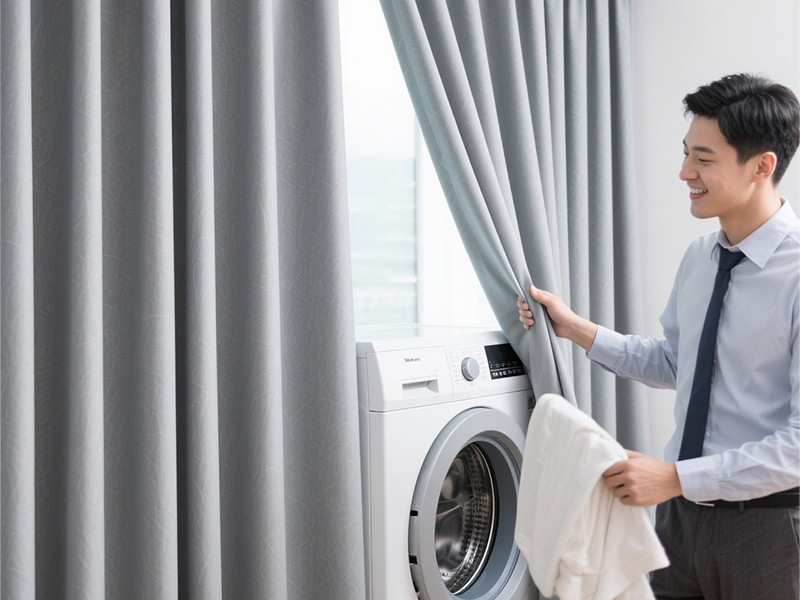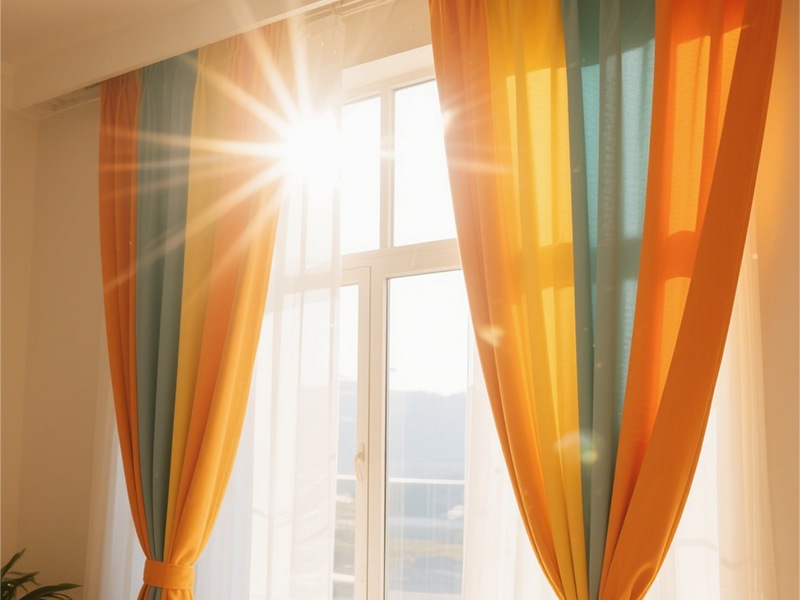close
Choose Your Site
Global
Social Media


Views: 0 Author: Site Editor Publish Time: 2025-07-15 Origin: Site

How to choose curtain fabric Choosing the right curtain fabric can transform a room. Did you know the fabric you choose impacts light control, privacy, and room ambiance? The right curtains not only elevate your space but also serve practical purposes.
In this post, we’ll explore why selecting the perfect curtain fabric matters. You'll learn how to consider factors like room function, fabric durability, and the level of privacy you need. Keep reading to discover how to make the best fabric choice for your home.

The first step in choosing curtain fabric is understanding the room's function. For example, living room curtains typically need to balance light and privacy, while bedroom curtains might focus more on blocking light for better sleep. Room style also plays a role—formal rooms may benefit from heavier, luxurious fabrics like velvet, while casual spaces might be better suited to light, airy fabrics like linen.
When deciding on fabric, think about how you want the space to feel. Do you want something that creates a relaxed atmosphere, or are you aiming for a more sophisticated vibe? Fabrics like cotton or linen are great for relaxed, natural settings, while heavier fabrics like velvet or brocade lend a more formal look.
Light control and privacy are essential considerations. If you're in need of privacy but also want to let some light in, sheer fabrics are perfect. They soften the light while offering a degree of privacy. On the other hand, if total darkness is crucial, blackout fabrics are the way to go, especially for bedrooms or media rooms.
Don't forget about lining! Adding a lining to your curtains can help control light, enhance privacy, and even add a layer of insulation. The weight of the fabric itself also affects how much light it lets through. Lighter fabrics allow more light to filter, while heavier fabrics will block more.
Durability matters, especially in high-traffic areas or homes with pets and kids. Natural fabrics like cotton or linen are soft but might wear down quicker with frequent use. If you're looking for something more durable, consider synthetic options like polyester, which are easy to clean and more resistant to wear.
Stain resistance is another factor to think about. Fabrics like polyester are more resistant to stains, while natural fabrics like linen may require extra care. If you want low-maintenance curtains, opt for synthetic materials, but if you’re looking for something more eco-friendly and breathable, natural fabrics might be worth the extra effort.
Natural fabrics like linen and cotton are popular choices for curtains due to their breathable nature and classic look.
Linen: Known for its breathability and texture, linen gives a relaxed, casual feel. It’s great for airy, light-filled spaces, but it does have a downside: linen shrinks over time and can be prone to wrinkles. If you love the natural, textured look, linen is an excellent option, but it does require more care.
Cotton: Cotton is soft, smooth, and highly versatile, making it suitable for almost any room style. It comes in various textures, from lightweight to heavier weaves, and works well in both casual and more formal spaces. However, cotton can shrink and fade when exposed to sunlight for long periods.
Synthetic fabrics offer durability and practicality, making them ideal for high-use areas or homes with children and pets.
Polyester: It’s durable, easy to clean, and resistant to fading, mildew, and wrinkles. Polyester is perfect for those who want low-maintenance curtains. It’s also highly resistant to stains and holds up well against sun damage.
Rayon & Acrylic: These fabrics share some benefits with polyester, offering easy care and long-lasting use. They provide the softness of natural fibers but are less prone to shrinking. Acrylic is often used in heavier curtains for insulation and durability, while rayon adds a silky, luxurious finish to more formal rooms.
When choosing synthetic fabrics, look for ones that are fade-resistant and offer UV protection, especially for rooms exposed to a lot of sunlight.
Some fabric types cater to specific aesthetic needs, offering luxury and texture.
Velvet: Velvet curtains are luxurious, rich, and ideal for creating a formal, dramatic look. They provide excellent insulation and light blocking but are best for cooler climates due to their heavy, thick nature.
Silk: Silk exudes elegance and a soft sheen, making it perfect for creating a sophisticated atmosphere. However, it is more susceptible to moisture and requires delicate care. It's not the best option for humid or high-traffic areas but works wonderfully for special rooms like a formal living room.
Brocade: Known for its intricate patterns and textures, brocade fabrics add a regal, formal feel to a room. They are perfect for special settings like dining rooms or grand living rooms but may require more care due to their delicate nature.
Each of these fabric types offers unique benefits, depending on the look and function you're aiming for in your home.

When selecting curtain fabric, the weight and texture play a big role in how your curtains will look and feel.
Heavy Fabrics vs. Light Fabrics: Heavy fabrics like velvet or brocade hang well and add drama, making them perfect for formal settings. They block light effectively and provide insulation. Lighter fabrics like linen or cotton create an airy feel and let more light in, making them ideal for casual spaces.
How Weight Influences Drape and Hang: The weight of the fabric affects how it drapes. Heavier fabrics tend to hang straight down with little movement, creating a more structured, elegant look. Lighter fabrics, on the other hand, flow more freely and create a softer, more relaxed appearance.
Texture Enhances Room Style: Texture can completely change the vibe of a room. Smooth, silky fabrics like satin add a touch of luxury and sophistication. Textured fabrics, like linen or tweed, bring an organic feel, perfect for creating a cozy or rustic look.
The way your curtains drape and their fullness can make a huge difference in the final look of the room.
What is Drape and How to Evaluate Fabric Flow: Drape refers to how fabric flows and falls when hung. Fabrics with good drape, like velvet or silk, naturally form elegant folds and sways. On the other hand, stiffer fabrics may not flow as well and can give a more rigid appearance.
Fullness: For a balanced, luxurious look, curtains should have adequate fullness. The standard rule is to use fabric that is 1.5 to 2.5 times the width of your window. More fullness creates a plush, elegant appearance, while less fullness can make the curtains look flat and lackluster.
How Different Fabrics Impact Fullness: The fabric's weight and texture also affect how much fullness is needed. Heavy fabrics, like velvet, naturally provide more fullness and don’t require as much fabric. Lighter fabrics, such as linen, may need more fabric to achieve the same full, gathered look.
When selecting curtains, it's important to think about how they can enhance privacy and reduce noise.
Choosing Fabrics for Noise Insulation: Heavier fabrics, like velvet or thick cotton, are great for blocking out sound. If you live in a noisy area or want to soundproof a room, these dense fabrics will help absorb sound and keep your space quieter.
Balancing Privacy and Light Control: You’ll need to balance privacy with light. For rooms like living rooms where you want some light to filter in, sheer fabrics are perfect. However, if privacy is a top concern, opt for heavier materials, such as blackout curtains or thick linen, to block outside views while still allowing some light.
Curtains can do more than just look good; they also protect your home from the elements.
Fabrics That Block UV Rays: Certain fabrics, like polyester and thick cotton, can block UV rays, helping to protect your furniture and floors from fading. These fabrics are a great choice for rooms with plenty of sunlight, such as living rooms or sunrooms.
Temperature-Regulating Fabrics: Fabrics like linen and cotton are known for their ability to regulate temperature. These materials keep your space cool in summer and warm in winter by allowing some air flow. If you're looking for more insulation, choose heavier fabrics like velvet or thermal-lined curtains to maintain warmth during colder months.
When choosing curtain fabric, budget is a key factor.
Affordable Fabric Options vs. Luxury Choices: Not all fabrics are created equal, and their price can vary significantly. Synthetic fabrics like polyester are often more budget-friendly, while natural fabrics like silk and velvet can be expensive. However, it’s possible to find quality fabrics at various price points. The key is knowing what fits within your budget without compromising on the quality you need.
Finding the Balance Between Cost and Quality: If you're working with a limited budget, focus on durable fabrics that offer good value for money, such as cotton or polyester blends. Luxury fabrics like silk or brocade are perfect for special rooms, but using them selectively can keep costs down.
The fabric you choose should enhance the overall look of your space.
How Fabric Choice Ties Into the Overall Room Design: Curtains can be a central element of room design. They frame windows and help set the tone for the space. Consider the function of the room and how you want it to feel—whether cozy, luxurious, or relaxed. The right fabric can enhance the vibe you're aiming for.
Selecting Patterns and Colors to Match the Room’s Décor: Choose fabrics that blend well with your room's color scheme and existing décor. For a bold statement, opt for striking patterns and vibrant colors. For a more harmonious, subtle look, choose neutral tones or fabrics with gentle textures.
Statement Fabrics vs. Subtle Tones: Statement fabrics like large patterns, metallic threads, or bold colors can create a dramatic focal point in the room. If you prefer a more understated look, choose simple textures or muted tones to keep the attention on other elements of the room.
Choosing the right curtain rods and rings is just as important as picking the fabric. The hardware can either enhance or detract from the overall look of the room.
How to Select Rods That Match Your Fabric and Room Style: The rod should complement the curtain fabric and room décor. For heavier fabrics like velvet, use a sturdy, thick rod to support the weight. For lighter fabrics like linen, you can opt for a more delicate, streamlined rod. Make sure the rod’s style matches your room, whether it’s modern, rustic, or traditional.
Different Rod Options: There are many types of rods to choose from:
Wooden rods: Great for a rustic or traditional look.
Metal rods: Sleek and modern, perfect for contemporary interiors.
Extendable rods: Adjustable in length, offering flexibility for different window sizes.
Fixed tracks: Often used for heavy curtains, these tracks are ideal for larger windows or more formal spaces.
Hardware Finishes and Their Impact on the Room's Appearance: The finish of the rod plays a significant role in the overall look. Matte black or brushed metal finishes are great for modern spaces, while gold or brass rods add a touch of luxury and elegance. The right finish can tie your curtain hardware into the room's color scheme.
In addition to rods, curtain tracks and suspension systems provide another functional and aesthetic option for hanging curtains.
The Advantages of Using Curtain Tracks vs. Rods: Curtain tracks provide a clean, streamlined look, especially for rooms with modern décor. They are often used for curtains that slide easily and smoothly, without the interruption of rings or hooks. Rods, on the other hand, can create a more traditional or decorative look, depending on the style of the curtain.
Types of Tracks:
Extendable tracks: Adjustable, great for different window widths.
Face fix tracks: Fixed to the wall, ideal for modern looks.
Heavy-duty tracks: Stronger, designed to hold heavier fabrics.
Top fix tracks: Mounted on the ceiling for a more minimalist, floating curtain effect.
Cable Suspension Systems and Other Modern Hardware Options: Cable systems are ideal for lightweight curtains and create a sleek, minimalist appearance. These systems use wires instead of traditional rods or tracks, making them a great option for modern spaces.
Measuring your windows correctly is key to making sure your curtains fit perfectly.
How to Measure Window Height, Width, and Desired Curtain Length: Start by measuring the width of your window, from one side to the other, and then add extra width for fullness. For height, measure from the top of the window frame to the desired bottom length, whether that’s just above the floor, to the floor, or puddling on the floor. It’s important to measure carefully to avoid any surprises later.
Accounting for Curtain Fullness and Stacking: Fullness is the amount of fabric needed to make the curtains appear voluminous and rich. Generally, curtains should be 1.5 to 2.5 times the width of the window, depending on how full you want them. For stacking (the area where curtains fold when open), add extra width so the curtains don’t crowd the window when pulled aside.
Once you've measured your window, it’s time to figure out how much fabric you need.
Estimating Fabric Yardage Based on Window Size and Fullness: To calculate fabric yardage, multiply the width of your window by the fullness factor (1.5 to 2.5). Then, divide this number by 36 (the number of inches in a yard) to get your total yardage. For example, if your window is 60 inches wide and you want 2x fullness, you’ll need 3.33 yards of fabric.
How to Adjust Fabric Needs for Different Fabric Types and Patterns: Keep in mind that fabric type and pattern can affect your yardage. Heavier fabrics like velvet or brocade often need less fullness, while lighter fabrics, such as linen or cotton, may require more. If you're working with patterned fabric, ensure that the pattern matches up at the seams. You might need extra fabric for pattern repeats.
Taking good care of your curtains helps preserve their beauty and longevity. Here are some tips on how to maintain different types of fabrics.
Tips for Washing and Caring for Specific Fabrics:
Linen: Linen curtains should be hand-washed or machine washed on a delicate cycle with cold water to avoid shrinking. Line drying is best to prevent wrinkles.
Cotton: Cotton curtains are easy to care for and can be machine washed on a gentle cycle. Dry on low heat or air dry to avoid shrinkage.
Polyester: Polyester is durable and can be machine washed. It resists wrinkles, so it’s less prone to needing ironing.
Stain Removal and Fabric Protection Techniques:
For stains, treat them promptly by blotting (not rubbing) with a clean cloth. Use a mild detergent or fabric stain remover for stubborn stains. Always test a small hidden area first to avoid damage.
Fabric protection: Consider using a fabric protector spray to prevent stains and keep your curtains looking fresh longer. Make sure to choose a product suited for the specific fabric type.
How to Preserve Fabric Quality Over Time:
Rotate curtains regularly to ensure even exposure to sunlight and prevent fading.
If curtains are frequently exposed to sunlight, consider using UV-protective lining to protect the fabric from damage.
For heavy fabrics like velvet, avoid frequent washing; instead, spot clean when necessary. Lightly vacuuming curtains can also help maintain their appearance by removing dust and debris.
When choosing curtain fabric, consider the room’s function, style, and fabric care needs. Think about light control, privacy, and the durability of materials. Always balance aesthetics and practicality.
Experimenting with different textures, colors, and patterns can help enhance your space. Choose fabrics that reflect your style while meeting functional needs for a perfect curtain solution.
A: Heavy fabrics like velvet or cotton blends are ideal for blocking light effectively.
A: Synthetic fabrics like polyester are ideal for humid environments due to their moisture resistance.
A: Sheer curtains provide some privacy but are better for light filtering. Consider layering them with other fabrics for enhanced privacy.
A: Choose light-colored fabrics and use vertical patterns to create an illusion of height and space.
A: Opt for UV-resistant fabrics like polyester or add UV protective lining to prevent sun damage.